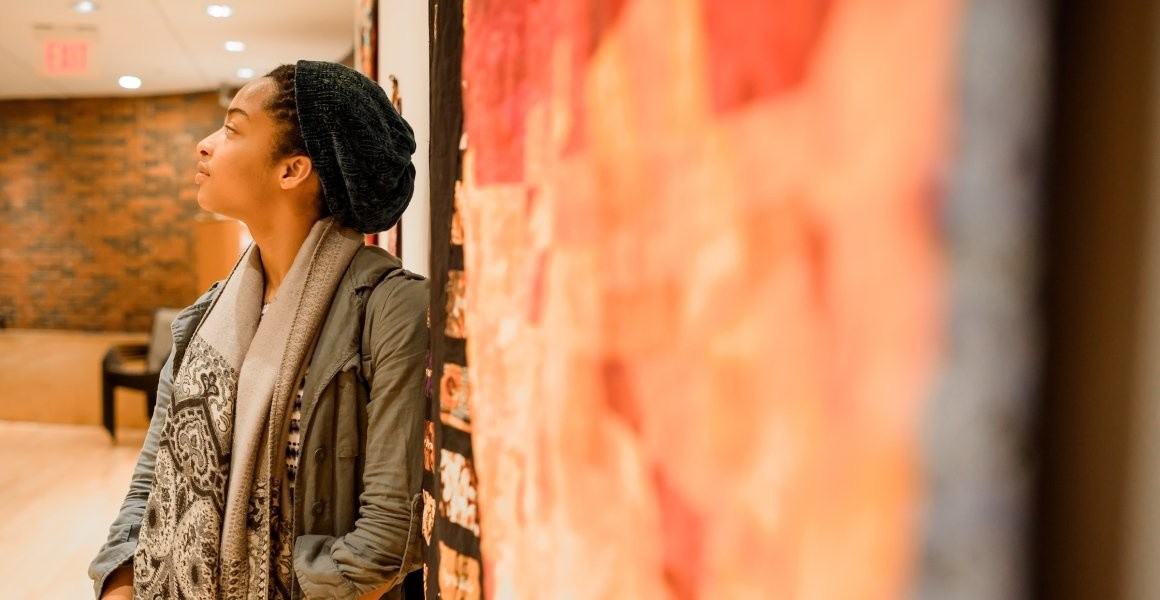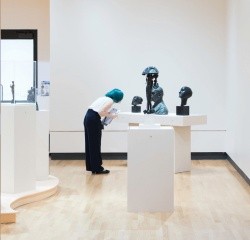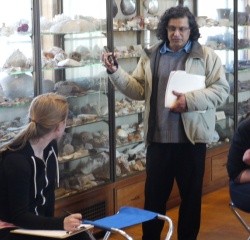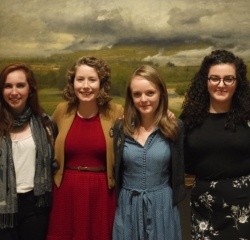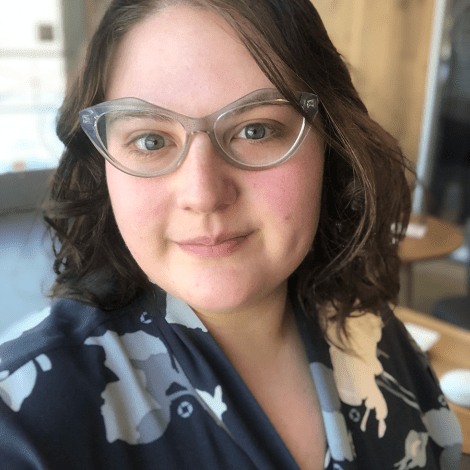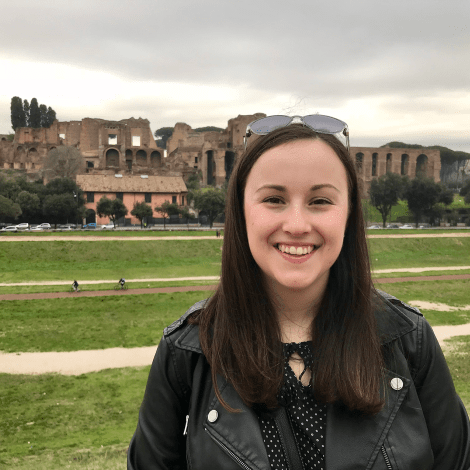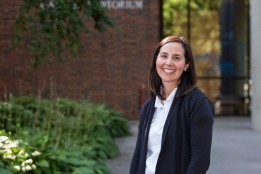ARTH-101 The Built Environment
Architecture may have originated as a response to basic human needs, but it very quickly took on complex meanings that transcend practicality. This course focuses on architecture from prehistory to the present, including buildings, cities, and urban planning; infrastructure and engineering; the unbuilt (and unbuildable) as well as the built world. Case studies cover design and theory as well as history. Individual projects and sites are explored as windows onto design principles, problems, and solutions; changing techniques, materials, and concerns; and human needs, desires, and ideals as manifested in the built world.
ARTH-102 Art and Architecture in the Premodern World
This global survey of premodern art and architecture introduces students to a wide array of cultures across time and geographies. Each class will center on one monument of world heritage and include a discussion of its context and associated artifacts. Over the semester, students will gain a broad perspective of how humans invested their time and resources into monumental art and architecture. Sites featured in the course include Stonehenge, the Egyptian Pyramids, the Assyrian palace of Nimrud, Dura Eurpos, Hagia Sophia, the Dome of the Rock, the Great Stupa at Sanchi, the Todaiji Temple at Nara, Lalibela, Notre Dame of Paris, Ani, Angkor Wat, Chichen Itza, and Machu Picchu. For each of the sites discussed, we will look at a variety of media, from architecture, to sculpture, metalwork, manuscripts, frescoes, mosaics, and reliefs.
ARTH-103 Western Art: 1400-2000
Art has the power to drive as well as reflect history. This course explores artists, images, objects, and buildings that have defined identity, sparked revolution, and changed how people think and act over the last seven centuries. Case studies include works that define the western tradition and others that interrogate its complicated legacy. We will see the rise of the very concept of Art along with the heightened status of the artist in society, the origins of the art museum and of the commercial art market. Students gain art-historical skills and learn to analyze the mechanisms by which creative expression shapes history, politics, and beliefs.
ARTH-104 Talking Pictures: An Introduction to Film
Some of the best feature-length films of the past century have commanded our attention and imagination because of their compelling artistry and the imaginative ways they tell stories visually and verbally. This course closely studies narrative films from around the world, from the silent era to the present, and in the process it introduces students to the basic elements of film form, style, and narration. Some of the films to be considered are: Battleship Potemkin, Citizen Kane, Contempt, The Bicycle Thief, Ugetsu, Rear Window, Woman in the Dunes, The Marriage of Maria Braun, Days of Heaven, and Moulin Rouge.
ARTH-105 Arts of Asia
This multicultural course introduces students to the visual arts of Asia from the earliest times to the present. In a writing- and speaking-intensive environment, students will develop skills in visual analysis and art historical interpretation. Illustrated class lectures, group discussions, museum visits, and a variety of writing exercises will allow students to explore architecture, sculpture, painting, and other artifacts in relation to the history and culture of such diverse countries as India, China, Cambodia, Korea, and Japan.
ARTH-231 Northern Renaissance Art
This course covers the arts in Northern Europe during a time of upheaval. We will look at developments in panel painting, manuscript illumination, printmaking, and sculpture from the fourteenth to sixteenth centuries -- examining shifting patterns of patronage and production along with shifting styles, techniques, and media. We will consider major artists like Jan van Eyck, Albrecht Durer, and Pieter Bruegel, as well as seismic cultural shifts such as the print revolution, the emergence of the woman artist, the Reformation, and the origins of the art market.
ARTH-232 Renaissance Cities
ARTH-232FR Renaissance Cities: 'Florence'
The origins of the Italian Renaissance are usually traced to one city, Florence, where a cultural revival sparked around 1400 gained momentum, ultimately radiating through Europe and beyond to become enshrined in the western canon. This course will bring Renaissance Florence back down to Earth by grounding its remarkable creative energy in a convergence of social and historical factors. Taking the long view from the 1200s to the 1500s, we will see how war, plague, belief, ritual, politics, gender, and local and global concerns all played a role in shaping the city's art, architecture, and urban form.
ARTH-232RM Renaissance Cities: 'Rome'
Renaissance Rome was a bundle of contradictions: a place of earthly corruption and sacred pageantry, crumbling ruins and glittering palaces, decay and renewal. While still impressive, the city had fallen far from its ancient glory days as capital of an empire. This course begins in the early 1400s, when the papacy returned after an absence of more than a century to reclaim a rundown, depopulated, lawless place. We trace the remarkable series of artistic, architectural, intellectual, and urbanistic transformations that, by 1600, had prepared Rome for a renewed role on the world stage.
ARTH-233 Italian Renaissance Architecture
Renaissance Italy gave rise to an extraordinarily influential version of classical architecture. Figures like Brunelleschi and Palladio took their cues from antiquity while moving beyond it to pioneer new techniques and designs. In this class, students explore developments in building types such as churches, palaces, and villas, as well as urban planning and landscape design. Recurrent themes include the rise of the professional architect, the development of the written treatise, the balance of theory and practice, and the role of patronage. In Renaissance culture, architecture was more than functional: it was a public statement that could project power, taste, and status.
ARTH-236 The Global Renaissance
This class turns away from the conventional Eurocentric narrative of the Renaissance, reframing it as a time when exploration and cross-cultural encounters inspired a rich and varied array of art, architecture, and sculpture. The objects we will examine include world maps from Europe and China, West African ivories, Benin bronzes, Indian miniatures, Islamic metalwork, Mexican feather paintings, Aztec cartography, colonial Latin American buildings and murals, as well as European paintings and illustrated books. All of these items speak to expanding networks of trade and conquest. Collectively, they show just how global and connected the Renaissance world really was.
ARTH-241 Nineteenth-Century European Art: Neoclassicism to Impressionism
This course will survey art in Europe from the French Revolutionary era to the last quarter of the nineteenth century -- or, in the language of art history, from the neo-classical painters (David and his atelier) to the great painters of modern life in Paris (Manet and his followers). This chronology represents one of the most important transformations in the history of art: the origins and early development of what we today call "modern art." We will spend considerable time tracing this difficult passage, pausing here and there to readjust ourselves to the shifting language of art and to orient art's relationship to the modern public.
ARTH-242 History of Photography: The First Hundred Years
This course surveys the first century of photography, beginning with its putative birth in 1839 and following its shifts and turns until the eve of World War II. We will look at a variety of photographic types: the daguerreotype, calotype, tintype, albumen and gelatin silver prints, and more. We will assess a range of practices: studio portraiture, commercial pictures, vernacular photography, journalism, and the fine arts. And we will follow camerawork in a variety of settings: China, England, France, Germany, Mexico, Russia, and the U.S.
ARTH-244 Global Modernism
This course examines the great ruptures in late 19th and early 20th century art that today we call modernist. It relates aspects of that art to the equally great transformations outside the studio: political revolution, the rise and consolidation of industrial capitalism, colonization and its discontents, and world war. It compares different kinds of modernisms, including those in Austria, France, Germany, Mexico, Spain and Russia.
ARTH-245 Hot Art During the Cold War
This course traces the different paths of painting, sculpture, and mixed media in the United States and, to a lesser extent, Western and Eastern Europe between 1945 and 1989. It begins with both the "climax" and "crisis" of modernism in midcentury and the movements and works that the crisis spawned. In the second half of the course, it follows art's relationship with a variety of postmodern subjects and debates. Throughout, it measures the effects of geopolitical tensions on the visual arts. Readings include a wide range of primary and secondary sources, with essays by art historians, critics, and artists.
ARTH-246 Photography As Art
In case studies beginning in the 1930s and continuing to the present, this course explores the many uses of photographs as art. It regards pictures made as individual art works as well as those objects using photographs and photographic materials as parts of an ensemble. We will trace a chronological but also winding path through different regions of the world, including experiments in Africa, Asia, and Europe, in addition to a more prominent concern with those in North America. Some of the case studies may include works by Ansel Adams, Eleanor Antin, Diane Arbus, Henri Cartier-Bresson, Robert Frank, Anselm Kiefer, An-My Le, Dinh Q. Le, Robert Mapplethorpe, Martin Parr, and Fazal Sheikh.
ARTH-250 American Art
A survey of painting and sculpture, this course introduces students to the work of individual artists. Classes also develop ways of looking at and thinking about art as the material expression of American social, political, and cultural ideas, including the depictions of nature, race, revolution, and country life. The course focuses on "American Masters": Copley, Stuart, Cole, Church, Eakins, Homer, Sargent, Whistler, and Cassatt are some of the key artists.
ARTH-290 Issues in Art History
ARTH-290AN Issues in Art History: 'The Garden in the Ancient World'
Drawing on the literature, art, and archaeology of gardens, this course investigates the nature and experience of gardens and gardening, from antiquity to the present day. How have humans conceived of the garden as paradise; a site for philosophy and religion; a space for solace, inspiration, and desire; and a setting for labor, conquest, and resistance? Grounded in readings from antiquity -- ranging from the Sumerian Hymn to Ninurta, Homer, Sappho, Vergil, Horace, Columella, and Augustine (all in translation) -- and complemented by later historical perspectives, from Jane Austen to Jamaica Kincaid, this course analyzes multiple conceptions and expressions of beauty, power, and love-in the garden.
ARTH-290AR Issues in Art History: 'Art and Experience in Ancient Rome'
To see and be seen -- it could be argued that this was the very definition of Roman culture. In this course, lectures on the art and architecture of ancient Rome (ca. 300 BCE - 400 CE) will provide the backdrop for an investigation of the central role that visual culture played in the lives of different social groups, including bondspeople and the formerly enslaved, women and children. Special topics will include the funeral as performance, the house as a site of memory, the dissemination of images on coins, the spectacle of agriculture and dining, art and audience in the racetrack and public baths, representations of work by non-elites, and the Roman street as a place for making art.
ARTH-290BC Issues in Art History: 'Bollywood: A Cinema of Interruptions'
Indian popular cinema, known commonly as Bollywood, is usually understood to have weak storylines, interrupted by overblown spectacles and distracting dance numbers. The course explores the narrative structure of Bollywood as what scholar Lalitha Gopalan calls a "constellation of interruptions". We will learn to see Bollywood historically, as a cultural form that brings India's visual and performative traditions into a unique cinematic configuration. We will analyze a selection of feature films, read scholarly articles, participate in debates, write guided assignments, and pursue independent research papers in order to understand Bollywood's uniqueness in relation to world cinema.
ARTH-290CA Issues in Art History: 'Modern Architecture: From Canon to Anticanon'
This course surveys major developments in the history of modern architecture from 1850 to the present. We will look at how new materials and emerging technologies changed the underlying possibilities of architectural form, with deliberate focus on how political changes at a global scale -- from world war conflagrations to anticolonial independence movements -- shifted the social stakes of modern architecture. We will cover canonical projects of modern architecture and contextualize them within their larger sociopolitical landscape, leaving room to examine many fascinating buildings that lay outside dominant narratives of modernization.
ARTH-290MA Issues in Art History: 'High Renaissance and Mannerist Art in Italy'
This course covers the development of the visual arts in the major artistic centers of Italy from the late 15th and 16th centuries through the lives and works of major artists, such as Leonardo, Raphael, Titian, and Michelangelo, and artists who are less familiar to viewers today. It focuses on thematic issues concerning the relationship between art and society, including the rise in social status of artists and the idea of artistic genius; the influence of patronage and collecting; art and the creation of artistic identities; women as subjects, patrons, and artists; classicism and "anti-classicism" (Mannerism); the Renaissance conception of queerness; art and religious form.
ARTH-290MV Issues in Art History: 'Art, Nature, and Ecology in the Medieval World'
From gardens of paradise to wild forests, silent deserts to raging seas, the natural world was a potent source of meaning and metaphor in the Middle Ages. This course examines human engagements with nature in art, architecture, and literature to reveal how medieval people were shaped by -- and also shaped -- the landscapes around them. Adopting a thematic and comparative approach, we will explore the intersections between medieval science, society, and religion. How did medieval peopleconceptualize the world around them? How did the landscape itself express power -- secular, sacred, and supernatural? To what extent do medieval ideas of landscape continue to shape our lives today?
ARTH-290RC Issues in Art History: 'Medieval Architecture'
This course presents a survey of architectural monuments from the Medieval Mediterranean world, broadly construed. In this region of great cultural diversity, the richness of architectural production flourishes and morphs with the rise and fall of empires. Beginning with the Late Antique basis of architectural typologies and ending with the Ottoman capture of Constantinople in 1453, we will move through the sacred and secular monuments of Anatolia, Eastern and Southern Europe, the Caucasus, Northern Africa, and the Levant.
ARTH-290RP Issues in Art History: 'Renaissance Print Culture'
Like the internet in our modern digital age, the Renaissance print was a revolutionary tool of communication -- one that held the power to incite violence, alter beliefs, shape popular taste, frame intellectual and artistic debate, and open new worlds. This seminar will trace the rise of print from its origins in western Europe around 1450 to the emergence of the international print market by about 1600. Frequent sessions in the Mount Holyoke College Art Museum and Special Collections will allow us to explore first-hand the physical and material properties of prints. In addition to their techniques, types, and functions, we will consider their commerce, growing circulation, and cultural impact.
ARTH-290SP Issues in Art History: 'Medieval Iberia: Art, Society, and Culture'
During the Middle Ages, the Iberian Peninsula was unique in its diversity: social and political, ethnic and religious, linguistic and cultural. This lecture course examines the art and architecture of Spain and Portugal from Late Antiquity to the Middle Ages from the perspective of the interconnections between its various communities. We will explore instances of coexistence and acculturation, periods of persecution and violence, and where these relations found visual expression. Course topics will proceed both chronologically and thematically, taking in subjects such as: religious architectures; court culture; identity, assimilation, and exclusion; and Iberia's connection with the wider European and Mediterranean worlds.
ARTH-290TK Issues in Art History: 'Art History Toolkit: Research, Writing, Methods, Careers'
Geared toward new and prospective majors, this course covers art historical research, writing, critical methods, and career options. Students gain research proficiency in digital and analog library resources. They practice a wide range of scholarly and professional writing types. Readings and discussions highlight theories, methods, and urgent questions facing the field today, while invited speakers give an overview of the professional possibilities. Assignments include oral presentations and exhibition designs as well as frequent written work. The overarching goal is a strong foundation in art history as a discipline and a skill set that can lead to a rewarding future.
ARTH-290WA Issues in Art History: 'Where Are Our Women Artists? Mapping Femme Creatives Across Time and Borders'
This course will seek to learn where femme creators, across the centuries and around the globe, lived, worked, and exhibited their art. It will ask students to research academic texts, museum exhibition catalogues, auction house sales, and other archival materials to find and make space for women creators who have remained unacknowledged or underappreciated. We will look at traditional objects such as paintings and sculptures as well as performance art, video art, film, fiber arts, decorative arts, handiwork, craftwork, and others to reimagine who and what works belong in a new history of art.
ARTH-295 Independent Study
ARTH-300AM Seminar: 'Architecture in Miniature in Asia'
The course explores small objects that allude to large spaces in different periods and regions of Asia. Portable objects represent real and imaginary buildings in Buddhist Central Asia, Islamic West Asia, and Chinese tombs. Persian miniature paintings are sectioned into architectural enclosures. Chinese landscape paintings and Japanese "dry" gardens compress the natural environment itself. In an active learning environment, we will experience the pleasure of scale-shift in small things. We will examine scholarly articles, write persuasive essays, visit Mount Holyoke's Art and Skinner museums, and make "archimorphic" objects in the Fimbel Maker and Innovation Lab.
ARTH-300MY Seminar: 'Building After Rome: Early Medieval Architecture'
Even in ruins, the buildings of ancient Rome still amaze us: luxurious villas and palaces, monumental theaters and bathhouses, even a strikingly modern-looking public infrastructure. But how did architecture change after the Western Roman Empire's collapse in the fifth century CE? This seminar delves into the architecture of Late Antiquity and the Early Middle Ages (ca. 300-ca. 800 CE). We will range across geographic and religious boundaries to consider themes such as: the effects of the so-called "Fall of the Roman Empire" on architectural practice; religious architecture; patronage, labor, and materials; and cross-cultural connections in the Mediterranean world.
ARTH-301 Topics in Art History
ARTH-301DG Topics in Art History: 'Indigenous Futures'
This course examines how contemporary artists from the Andes and the Amazon imagine and represent the future of their communities by putting their experiences, aesthetics and epistemologies in dialogue with global issues, such as the environmental crisis. Through analysis of a diverse corpus of works -- from Guamán Poma's 17th century drawings, to Daniela Catrileo's 2023 novel Chilco -- we will examine how indigenous artists and thinkers have imagined other worlds and realities, and we will explore how these works challenge ideas around race, nation, gender, and class. Students will also have a chance to test their own critical imaginations by producing narratives about the future.
ARTH-301MH Topics in Art History: 'Making History'
This research seminar looks at the relationship between historical painting and the history it depicts. How much is fact; how much is fiction; and how do we explain the differences? To what ends was it painted? The focus will be on contemporary history painting in the period 1770-1875. The first half of the semester will examine these questions using critical theory and real examples. Students will then develop a major American, British, or French history painting for sustained research and analysis. Possible pictures include Turner's Slave Ship, Gericault's Raft of the Medusa, Copley's Watson and the Shark, David's Marat, and others. Numerous papers and class presentations.
ARTH-302RM Great Cities: 'Rome, the Eternal City'
This seminar will survey the past, present, and future of the Eternal City through its remarkable art, architecture, and urbanism. We will examine the material traces of Rome's journey from ancient capital to center of Christianity, seat of the caesars to that of the popes and prime ministers, beacon to pilgrims and tourists, then finally modern capital and -- perhaps -- sustainable city. Despite its problems, this "mother of all cities" continues to be a model of urban relevance and staying power.
ARTH-321 Objects of Exchange
This seminar explores the interconnected medieval world, especially across the Mediterranean. Each week will examine a thematic group of "exchange objects" at the crossroads of cultural, linguistic, and religious connections. Some of these objects, such as coins, were literal objects of exchange, serving as the mode of transmission for material and visual exchange. In other cases, the materials or details of a work signify connections to the wider world through trade. Still others are hybrid objects, or objects combining features from multiple traditions. Over the course of the semester, students will gain a better understanding of the diversity of the medieval Mediterranean, as well as the extent of premodern mobility of peoples, objects, and ideas. The course will feature direct engagement with objects whenever possible.
ARTH-340 Seminar in Modern Art
ARTH-340AM Seminar in Modern Art: 'After Impressionism'
This seminar will focus on the works of four painters, and we will choose from among the following: Bonnard, Cezanne, Gauguin, Pissarro, Seurat, Toulouse-Lautrec, and van Gogh. We will study their works in relation to the feverish debates about painting in the 1880s and 1890s that the previous generation's Impressionism brought about. As we will discover, the four artists were hardly a unified group, took distinct paths away from Impressionism, and pursued projects that had limited allegiance to its main tenets or, indeed, to the ideas and practices of each other. In all, they will represent the extraordinary vitality of art suddenly loosened from the academic world.
ARTH-352 Topics in Modern and Contemporary Architecture
ARTH-352LW Topics in Modern and Contemporary Architecture: 'Spaces of Law'
While law is often seen as an abstract discipline, its practice is embedded within our built environments quite concretely. This seminar surveys spaces of law, with attention to the many ways architecture has historically shaped modern legal concepts. We will ask: How has legal authority been reflected or produced by the design of legal space, as exemplified by the spatial arrangements of the courthouse? How does architecture frame legal evidence? How has the historical development of state-sanctioned punishment been reflected in urban space or architectural form? And finally: how can we use evidence in the built environment to reveal moments of resistance against legal authority?
ARTH-370 Research in Art History and Architectural Studies
ARTH-370TM Research in Art History and Architectural Studies: 'Time'
This advanced seminar supports the development of independent research projects in art history and architecture. The course will cover general topics related to design research, art history research and writing, including formulating research questions, locating and positioning primary and secondary sources, and developing an argument. In addition to scaffolding individual students' projects, a primary aim of the seminar will be to foster discussion across topics of inquiry and methods of research. By sharing works-in-progress at several key moments in the semester, the seminar provides space for collective learning and peer feedback.
ARTH-395 Independent Study
